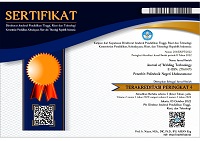Analysis of current variation and solvent flux type on microstructure and hardness of type 304 austenitic stainless steel welded by Tungsten Inert Gas welding
Abstract
Keywords
Full Text:
PDFReferences
Dipali Pandya, Amarish Badgujar, Nilesh Ghetiya, “A novel perception toward welding of stainless steel by activated TIG welding: a review”, Materials and Manufacturing Processes, Volume 36, pages 877-903, 2021.
Vidyarthy, R. S. and D. K. Dwivedi. “Activating Flux Tungsten Inert Gas Welding for Enhanced Weld Penetration.” Journal of Manufacturing Processes 22:211–28. 2016
Annette O’Brien, Welding Processes, Part 1, Welding Hanbook Ninth Edition, American Welding Society, 2004
Huang HY, Shyu SW, Tseng KH, Chou CP. “Study of the Performance of Stainless Steel A- TIG Welds”. Journal of Material Engineering and Performance. 2007
Khanna, O.P.” A Text Book of Advance Welding Technology”. Dhanpat Rai Publicat ion (P) Ltd., 1999.
Eistein Yazid, Kimia Fisika Untuk Paramedis. Penerbit Andi, Yogyakarta. 2005
Kurtumulus, Memduh. “Activated TIG Welding of Austenitic Welding”. Marmara University Technology Faculty, Goztepe Campus, Istanbul, 2017.
Tseng, Kuang-Hung. “Development and Application of Oxide-based Flux Powder for Tungsten Inert Gas”. Institute of Materials Engineering. National Pingtung University of Science and Technology, Pingtung 91201, Taiwan. 2013.
Sido Kou, “ Welding Metallurgy”, A John Wiley & Sons, Inc., Publication, 2003
A. Rodrigues and A. Loureiro, “Effect of Cooling Rate on the Microstructure and Hardness of Austenitic Stainless Steel Welds,” Mater. Sci. Forum - MATER SCI FORUM, vol. 455–456, pp. 312–316, May 2004, doi: 10.4028/www.scientific.net/MSF.455- 456.312
Lippold J.C., Kotecki D.J. “Welding Metallurgy and Weldability of Stainless Steels”, Wiley- Interscience. 2005
DOI: http://dx.doi.org/10.30811/jowt.v4i1.2948
Refbacks
- There are currently no refbacks.

This work is licensed under a Creative Commons Attribution-ShareAlike 4.0 International License.
Ciptaan disebarluaskan di bawah Lisensi Creative Commons Atribusi-BerbagiSerupa 4.0 Internasional.
Mailing Address:
Politeknik Negeri Lhokseumawe
Jl. Banda Aceh-Medan
Km. 280,3, Buketrata, Mesjid Punteut, Blang Mangat,
Kota Lhokseumawe, 24301
Propinsi Aceh,
Indonesia























